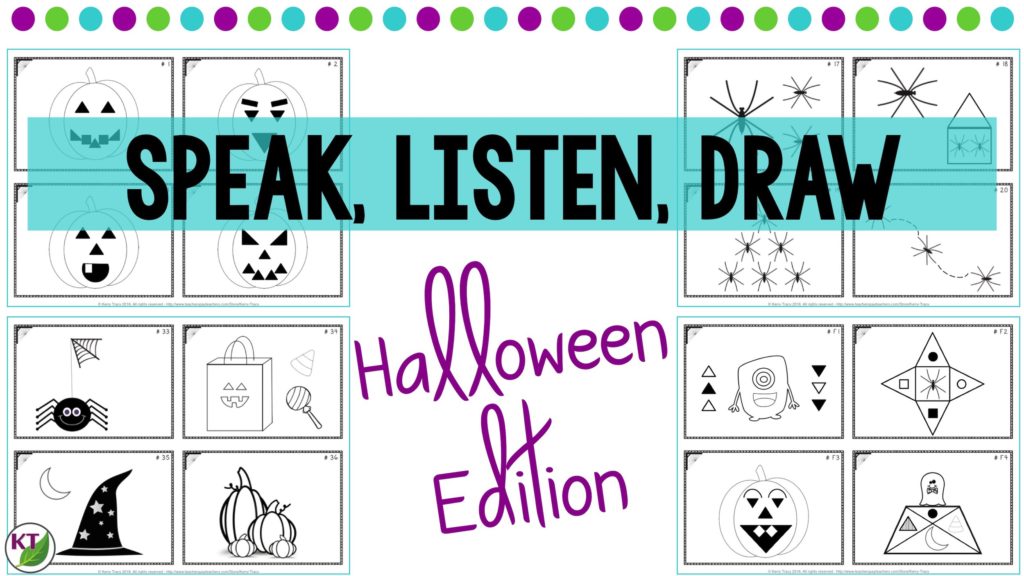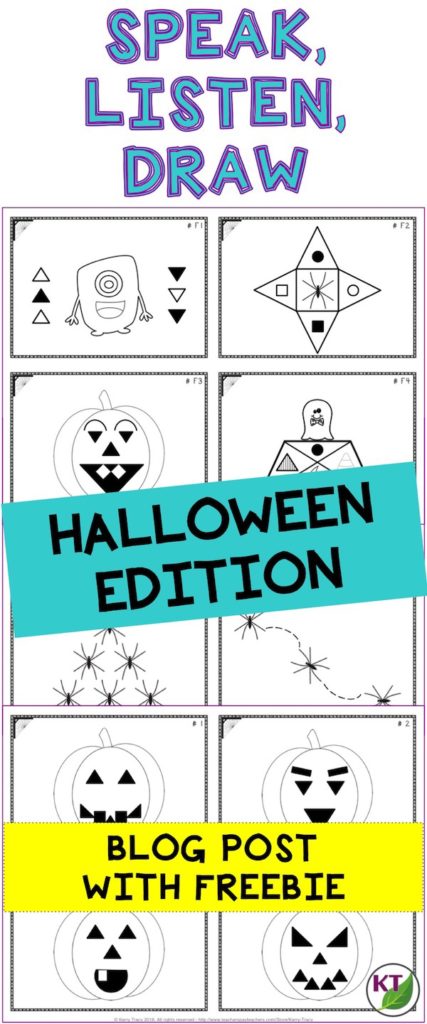I love, love, love this communication activity! It’s simple, but powerful, and adjustable to any age. In fact, when I was using this with my niece (age 4) and nephew (age 12), my brother (age 36) couldn’t help himself and asked to join in. I’m dying for everyone to try this out, so I’ve created a freebie for you to try out in your class. You’ll find it at the bottom of this post. (Stay tuned for a video/audio example from this family day of fun coming soon!)

What Is It?
The premise is simple: one person describes what they see on a drawing card as clearly as possible while their partner draws based on the oral directions. Anyone can do, but the older student, the more sophisticated you can get with the drawings and types of directions. Advanced students may even challenge themselves to give the directions in the fewest sentences or fewest words.
Why I Made It
Have you ever tried to get students to communicate clearly what they want to convey? It can be pure drudgery — but it doesn’t have to be! I noticed that when I would ask students to create process flow writing (steps to create their STEM Challenge designs, how to make a sandwich, etc.), their writing often left out key steps. I wanted an activity that would help them practice being detailed in their directions. This is quick, easy, and enjoyable. Students practice LOTS of skills whether they are the ones giving or receiving directions. I also found it was a way to sneak in some math review by having students use estimation and measurement skills to give clearer directions. By adding shapes, parallel lines, etc. in the pictures, I could also get them to review geometry skills.
Skills Practiced
- Oral communication
- Listening
- Following directions
- Prepositions
- Estimation
- Measurement
- Geometry (depending on pictures)
Ways to Use
Whole-Class
Teacher or student volunteer directs whole-class, while the class draws the same picture. Pin all student drawings along with the original image on the board, or lay out on the ground. Compare and contrast the drawings to each other and the original. Discuss and reflect on the process.
Partners/Small Groups
- Partner up students. One acts as director, the other draws based on his/her directions. If there is an odd number of students, set one director with two illustrators.
- If you give the whole class the same two cards. When they’re done, have them pin to bulletin board and examine all the similarities and differences, as done in the whole-class version.
- Copy just one page. Place students in groups of 4. Have students set up folders for privacy.
- More than one illustrator shows the director gives the director feedback on how well he/she communicated and the listener how well he/she listened because there are multiple examples to compare and contrast. (If all illustrators made the same mistake, it’s likely a miscommunication from the director; if only one illustrator makes a mistake, he/she might not have listened carefully.)
Homework or Extra Credit:
Have students make or take a drawing card home and direct their parents or siblings draw it.
Reading/Writing Centers
- Make a copy of the director cards, cut, and place into envelopes with corresponding numbers. Make several copies of the student center directions for Options 1 & 2. Note: director cut-outs fit on a standard #10 business envelope. You will also need tape, glue, or paperclips for this center.
- Students have a choice to either write directions for an image or choose an envelope with directions already written and illustrate based on the directions. If the latter is chosen, the illustrator must provide written feedback to the writer/director.
- Option: Allow students to create their own drawings for this center.
- Option: Tech Savvy
- If you have the means, students can record themselves giving directions, or even create a short, narrated PowerPoint presentation. The second to last slide should warn the viewer/illustrator the answer/original image is coming, and the last slide would be a scan of the original image.
Increase Difficulty
Up the difficulty level with one of these versions:
- Tongue-Tied
- Write a list of five words student directors are likely to use (prepositions, shapes, fractions, etc.) on the board. Directors copy the list on scratch paper. They will be allowed to use these words only once as they direct, and must cross them out as they go, and use synonyms or other ways to describe in place of those words.
- Succinctly Yours
- Create the best set of directions possible, using the fewest number of sentences (gives students practice with complex, compound, and complex-compound sentences, if appropriate for your grade level).
- Create the best set of directions possible using the fewest number of words.
- Memory
- Have students give two or three clues at a time. Only after the second or third clue, the drawer picks up pencil and attempts to draw what he/she heard (no repeats allowed). Increase the number of clues the illustrator must hear before drawing to increase difficulty.
Get the Freebie:
What’s Included?
–Teacher Tips
How to use the task cards
Sample script
Cards at a glance
–Center directions
–4 director cards
–Blank set of cards for students to draw based on directions and/or to create their own.
Get the full Halloween Set (44 Director’s Cards):
Get the full Anytime Set (40 Director’s Cards):
:
PIN ME






